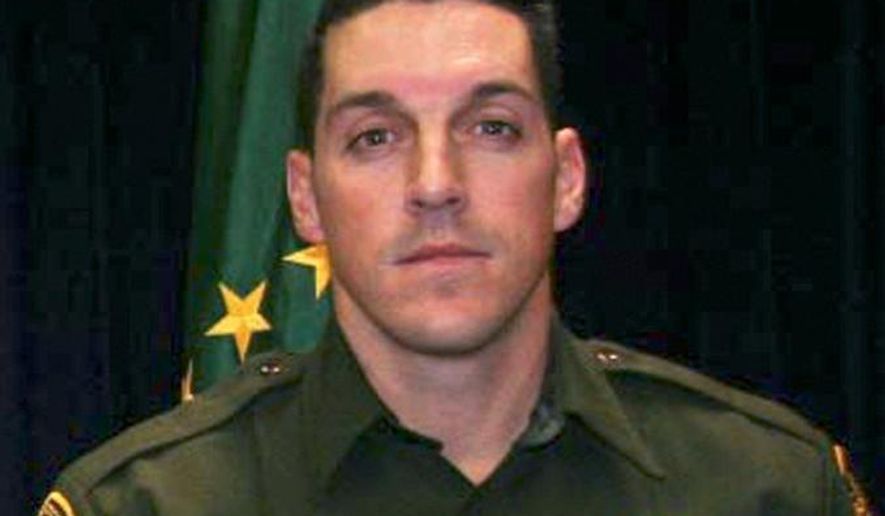Federal prosecutors closed out the final case against the men who killed Border Patrol Agent Brian Terry in a shootout linked to President Obama’s Fast and Furious gun scheme, concluding one of the darkest chapters in American border security.
Jesus Rosario Favela-Astorga was slapped with a 50-year prison sentence Wednesday after pleading guilty to murder, 12 years after he and four other men shot it out with Terry and fellow Border Patrol agents on rugged terrain just north of the Mexican boundary.
Three other men on the scene the night of Dec. 14, 2010, got life sentences. A fourth, who was shot in the stomach by agents, is serving 30 years. Two others connected to the “rip crew” but not present that night got eight- and 27-year sentences for their roles.
Two of the rifles the men carried that night were part of the Obama administration’s disastrous Operation Fast and Furious, which was supposed to be a way to track illegal gun sales, but at least 1,400 weapons were set adrift. Many of them ended up in the hands of Mexican criminals.
The operation was shut down in the wake of Terry’s death, but dozens of weapons continued to show up at crime scenes in Mexico, in addition to the two found at the scene where Terry was slain.
Kent Terry, Brian’s brother, said this week’s sentencing may close out the criminal cases, but he is still waiting for answers about the government’s role in supplying guns involved in the killing.
“That’s the million-dollar question,” he told The Washington Times on Thursday.
He is worried that the conditions at the border are deteriorating and putting other agents at risk, just as his brother was.
“I talk to a lot of border agents down there in the field, and it’s weak. And it all starts with leadership,” he said. “There’s going to be another agent that’s going to get killed for all the smuggling.”
Brian Terry signed up for the Border Patrol in 2006 and became an agent in 2007, just as attention to border security was intensifying. Congress had approved hundreds of miles of border wall, President George W. Bush had deployed the National Guard, and the Homeland Security Department was hiring thousands of agents.
Terry eventually would join the Border Patrol’s elite tactical squad, which was on patrol that December looking to take down drug runners.
Also out there that night was Favela-Astorga and his rip crew, searching for marijuana smugglers they could rob of their loads.
His attorneys argued that the rip crew didn’t know they were blasting away at federal agents and that it was the agents who ambushed them. Favela-Astorga contended they had no reason to think the Border Patrol was anywhere near them that night, rather than another drug smuggling team, and agents’ announcement of “Policia” was muffled by gunshots.
Prosecutors pointed out that the rip crew encountered agents just two days earlier. One man was arrested, and the rest dropped their backpacks and fled. That meant they knew Border Patrol agents were operating in the area, the government said.
During the firefight, agents used beanbag rounds before switching to their regular firearms, according to testimony from the other Border Patrol team members.
Authorities never proved who fired the shot that hit Terry in the lower back. One of the other agents recounted that Terry shouted, “I’m hit! I can’t feel my legs.” A fellow agent rushed to administer first aid, but Terry quickly lost consciousness and died at the scene.
The rip crew had five weapons: four AK-47s and an AR-15. The shot came from an AK-47, but tests to determine whether it was one of the two Fast and Furious guns were inconclusive.
The presence of Fast and Furious weapons became a black eye for the Obama administration’s Justice Department, which initially misled Congress about it and then stonewalled requests for documents.
The House voted to hold then-Attorney General Eric H. Holder in contempt of Congress. Democrats walked out of the vote in a show of solidarity with Mr. Holder.
Kent Terry called that “a slap in my brother’s face.”
The Justice Department declined to pursue the case against their boss.
Kent Terry said President Trump promised to force the release of all the documents to reveal the real story about Fast and Furious, but it never happened. He said he figured resistance within the Justice Department derailed the effort, though he hopes for answers eventually.
As for the prison sentences, he said they are “not enough.”
“They took a life that night,” he said.
While it bungled the Fast and Furious situation, the Justice Department showed zeal in pursuing Terry’s killers.
Favela-Astorga, who was charged with second-degree murder, fled back to Mexico and was tracked down in 2017, seven years after the slaying. He was extradited to the U.S. early in 2020.
In a statement after Wednesday’s sentencing, Randy S. Grossman, the U.S. attorney for the Southern District of California, whose office prosecuted the cases, said he hoped the conclusion of the final case could bring some closure.
“Today is for Brian Terry, and his loved ones and colleagues who waited 11 years to see justice come to all who were involved in his tragic murder,” he said. “We hope it fulfills the promise to everyone who protects us.”
The case was prosecuted in Arizona, where Terry was killed, but another prosecutor had to be brought in because the Obama administration’s U.S. attorney for Arizona was tainted by the Fast and Furious situation.
• Stephen Dinan can be reached at sdinan@washingtontimes.com.




Please read our comment policy before commenting.